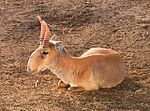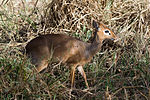Antilopinae: Difference between revisions
Content deleted Content added
→top: attempted to align the text with the classification below |
→top: rm non-antilopine info |
||
| (6 intermediate revisions by 6 users not shown) | |||
| Line 3: | Line 3: | ||
| name = Antilopinae |
| name = Antilopinae |
||
| image = Hirschziegenantilope2.JPG |
| image = Hirschziegenantilope2.JPG |
||
| image_caption = [[ |
| image_caption = Mature male Indian [[blackbuck]] (''Antilope cervicapra'') |
||
| taxon = Antilopinae |
| taxon = Antilopinae |
||
| authority = [[John Edward Gray|Gray]], 1821 |
| authority = [[John Edward Gray|Gray]], 1821 |
||
| Line 11: | Line 11: | ||
}} |
}} |
||
The ''' |
The '''antilopines''' are [[even-toed ungulate]]s belonging to the [[subfamily]] '''Antilopinae''' of the family [[Bovidae]]. The members of tribe [[Antilopini]] are often referred to as true [[antelope]]s, and include the [[gazelle]]s, [[blackbuck]]s, [[springbok]]s, [[gerenuk]]s, [[dibatag]]s, and Central Asian gazelles. True antelopes occur in much of Africa and Asia, with the highest concentration of species occurring in [[East Africa]] in [[Sudan]], [[Eritrea]], [[Ethiopia]], [[Somalia]], [[Kenya]], and [[Tanzania]]. The [[saiga]] (tribe [[Saigini]]) inhabits Central and Western Asia, mostly in regions from the [[Tibetan Plateau]] and north of the [[Indian Subcontinent]]. The dwarf antelope species of tribe [[Neotragini]] live entirely in sub-Saharan Africa. |
||
==Classification== |
==Classification== |
||
| Line 21: | Line 21: | ||
*** Genus'' [[Antidorcas]]'' |
*** Genus'' [[Antidorcas]]'' |
||
**** [[Springbok Antelope|Springbok]] ''Antidorcas marsupialis'' |
**** [[Springbok Antelope|Springbok]] ''Antidorcas marsupialis'' |
||
*** Genus ''[[ |
*** Genus ''[[Antilope]]'' |
||
**** [[Blackbuck]] ''Antilope cervicapra'' |
**** [[Blackbuck]] ''Antilope cervicapra'' |
||
*** Genus ''[[Eudorcas]]'' [[Image:Thomsons-gazelle.jpg|thumb|right|150px|[[Thomson's gazelle]] (''Eudorcas thomsoni'')]] |
*** Genus ''[[Eudorcas]]'' [[Image:Thomsons-gazelle.jpg|thumb|right|150px|[[Thomson's gazelle]] (''Eudorcas thomsoni'')]] |
||
Revision as of 15:33, 21 December 2023
| Antilopinae | |
|---|---|

| |
| Mature male Indian blackbuck (Antilope cervicapra) | |
| Scientific classification | |
| Domain: | Eukaryota |
| Kingdom: | Animalia |
| Phylum: | Chordata |
| Class: | Mammalia |
| Order: | Artiodactyla |
| Family: | Bovidae |
| Subfamily: | Antilopinae Gray, 1821 |
| Genera | |
|
See text. | |
The antilopines are even-toed ungulates belonging to the subfamily Antilopinae of the family Bovidae. The members of tribe Antilopini are often referred to as true antelopes, and include the gazelles, blackbucks, springboks, gerenuks, dibatags, and Central Asian gazelles. True antelopes occur in much of Africa and Asia, with the highest concentration of species occurring in East Africa in Sudan, Eritrea, Ethiopia, Somalia, Kenya, and Tanzania. The saiga (tribe Saigini) inhabits Central and Western Asia, mostly in regions from the Tibetan Plateau and north of the Indian Subcontinent. The dwarf antelope species of tribe Neotragini live entirely in sub-Saharan Africa.
Classification
Family Bovidae
- Subfamily Antilopinae
- Tribe Antilopini
- Genus Ammodorcas
- Dibatag Ammodorcas clarkei
- Genus Antidorcas
- Springbok Antidorcas marsupialis
- Genus Antilope
- Blackbuck Antilope cervicapra
- Genus Eudorcas

Thomson's gazelle (Eudorcas thomsoni) - Mongalla gazelle Eudorcas albonotata
- Red gazelle Eudorcas rufina †
- Red-fronted gazelle Eudorcas rufrifrons
- Thomson's gazelle Eudorcas thomsoni
- Heuglin's gazelle Eudorcas tilonura
- Genus Gazella
- Subgenus Deprezia
- Subgenus Gazella

Mountain gazelle (Gazella gazella) - Arabian gazelle Gazella arabica
- European gazelle Gazella borbonica †
- Chinkara or Indian gazelle Gazella benettii
- Queen of Sheba's gazelle Gazella bilkis †
- Dorcas gazelle Gazella dorcas
- Mountain gazelle Gazella gazella
- Saudi gazelle Gazella saudiya †
- Speke's gazelle Gazella spekei
- Subgenus Trachelocele
- Cuvier's gazelle Gazella cuvieri
- Rhim gazelle or slender-horned gazelle Gazella leptoceros
- Goitered gazelle Gazella subgutturosa
- Genus Litocranius

Gerenuk (Litocranius walleri) - Gerenuk Litocranius walleri
- Genus Nanger
- Dama gazelle Nanger dama
- Grant's gazelle Nanger granti
- Soemmerring's gazelle Nanger soemmerringii
- Genus Procapra
- Zeren Procapra gutturosa
- Goa Procapra picticaudata
- Przewalski's gazelle Procapra przewalskii
- Genus Ammodorcas
- Tribe Saigini

Saiga (Saiga tatarica) - Tribe Neotragini
- Genus Dorcatragus

Kirk's dik-dik (Madoqua kirkii) - Beira Dorcatragus megalotis
- Genus Madoqua
- Günther's dik-dik Madoqua guntheri
- Kirk's dik-dik Madoqua kirkii
- Silver dik-dik Madoqua piacentinii
- Salt's dik-dik Madoqua saltiana
- Genus Neotragus
- Royal antelope Neotragus pygmaeus
- Genus Ourebia
- Oribi Ourebia ourebi
- Genus Raphicerus
- Steenbok Raphicerus campestris
- Cape grysbok Raphicerus melanotis
- Sharpe's grysbok Raphicerus sharpei
- Genus Dorcatragus
- Tribe Antilopini
Fossil genera[1]
- †Demecquenemia
- †Deprezia
- †Dytikodorcas
- †Hispanodorcas
- †Homoiodorcas
- †Majoreas
- †Nisidorcas
- †Ouzocerus
- †Parantidorcas
- †Parastrepsiceros[2]
- †Praemadoqua[3]
- †Prostrepsiceros
- †Sinapodorcas
- †Tyrrhenotragus
References
- ^ "Antilopini". Biolib.
- ^ Kostopoulos, D. (1998). "Parastrepsiceros koufosi n. sp. (Mammalia: Bovidae); note on the possible presence of a Prostrepsiceros descendant in the latest Pliocene of northern Greece". Biology Acta Zoologica Cracoviensia.
- ^ "Praemadoqua". Fossilworks.





